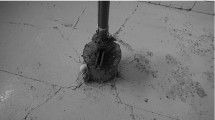Abstract
An evaluating method is proposed to investigate effect degree of seven damaged mountains of Jinan city, based on matter element model deduced from the theories of extenics. Using the effect degree classification and influencing factors on damaged mountains, the elements in classical and sectorized field are defined, whereby an extension-evaluating model is developed to evaluate the classification of effect degree of damaged mountains by the correlation function of matter elements and extension sets. The analytic hierarchy process methodology for calculating weight aggregation of evaluating factors is proposed. The evaluating results are thus obtained through such an evaluation. An exemplification is shown that the present method is effective and applicable to forecast the classification of effect degree of damaged mountains more accurately and scientifically, which lends the support for control planning for damaged mountains and a more reliable basis for taking economic and reasonable supporting/reinforcing measures.



Similar content being viewed by others
References
Cai W (1994) The matter element model and its application. Science and Technology Press, Beijing (in Chinese)
Cai W (1999) Extension theory and its application. Chin Sci Bull 44(17):1538–1548 (in Chinese)
Cai W, Yang CY, He B (1997a) Extension logic. Science and Technology Press, Beijing (in Chinese)
Cai W, Yang CY, Lin WC (1997b) The extension engineering method. Science and Technology Press, Beijing (in Chinese)
D’Amboise D, Gregorio SD et al (2003) A first simulation of the Sarno debris flows through cellular automata modeling. Geomorphology 54:97–117
Fan YX, Luo Y, Chen QS (2004) Extenics model for evaluating vulnerable degree of regional sustaining hazard body. Journal of China University of Geosciences pp 115–117
Jia C, Xiao SF, Liu N (2003) Application of extenics theory to evaluation of tunnel rock quality. Chin J Geotech Eng 5:751–756 (in Chinese)
Jinan Bureau of Land Resources (2007) Damaged mountain improvement project management supervision system 12:2–5 (in Chinese)
Jinan Bureau of Land Resources (2010) Planning project of damaged mountain in Jinan city (2010–2020) 1:2–5 (in Chinese)
Kang ZQ, Feng XT, Zhou H (2006) Application of exenics theory to evaluation of underground cavern rock quality based on stratification analysis method. Chin J Rock Mech Eng 10:3687–3693 (in Chinese)
Kang ZQ, Zhou H, Feng XT et al (2007) Evaluation of high rock slope quality based on theory of extenics. J Northeast Univ (Natural Science) 12:1770–1774 (in Chinese)
Kong FH, Yin HW, Nobukazu N (2007) Using GIS and landscape metrics in the hedonic price modeling of the amenity value of urban green space: a case study in Jinan City, China. Landsc Urb Plan 79:240–250
Liu LM, Guo WJ, Zhao ZH et al (2008) Matter-element model on optimal allocation of subsidence land resource. J Chin Coal Soc 6:623–628 (in Chinese)
Stephenson J (2008) The cultural values model: an integrated approach to values in landscapes. Landsc Urb Plan 84:127–139
Wang L (1999) Topology analysis for steadiness of side Slope of rock body. Hebei Metall 1:21–23 (in Chinese)
Wang Z, Yi FC (2009) Assessment on the susceptibility of geological hazards in Mianyang city based on analytical hierarchy process. J Nat Disasters 18(1):14–23 (in Chinese)
Wang ZL, Cai GL, Li YX et al (2003) Comprehensive assessment of urban commercial land quality based on extension mathematics. J Jiangsu Univ (Natural Science Edition) 7:87–91 (in Chinese)
Wu Q, Xing LT, Ye CH, Liu YZ (2011) The influences of coal mining on the large karst springs in North China. Environ Earth Sci 64:1513–1523. doi:10.1007/s12665-009-0376-y
Xie QM, Xia YY (2002) Improved hierarchy model of treatment decision of slope and its application. Chin J Geotech Eng 24(1):86–88 (in Chinese)
Xing LT, Fu Y, Jia JT et al (2012) Recovery technology for remediation of geological environment and spring in Jinan. 12:48–49 (in Chinese)
Xu SS (2006) Excel application in analytic hierarchy process. China Manag Inf 11(9):17–19 (in Chinese)
Xu Y, Zhu QX (2013) A new extension theory-based production operation method in industrial process. Chin J Chem Eng 21(1):44–54
Yang CY, Cai W (2000) Study on extension engineering. Eng Sci 2(12):90–96 (in Chinese)
Zhang AX (2009) Damaged mountain governance in Jinan High-tech Zone has remarkable results. Shandong Land Resour 25(1):46–47 (in Chinese)
Zhang GQ, Zhong YF, Zhang WG (2004) Mechanical Product Extensive Intelligent Conceptual Design. Chin J Mech Eng pp 1–5
Zhang YW, Yao CM, Wang YB et al (2007) Study on governance classification scheme of the damaged mountain in Shandong Province (in Chinese)
Zhang YW, Liu HN, Liu YB (2009) Analysis of landscape effect degree (led) in Shandong province. Shandong Land Res 2:24–26 (in Chinese)
Zhao RZ, Zhao P, Zhao HJ (2012a) The research of damaged mountains and technology of ecological restoration in Jinan. Shandong Land Resour 9:31–36 (in Chinese)
Zhao ZH, Li HT, Zheng LS et al (2012) Investigation of damaged mountain repair in Jinan City and information system construction 12:48–49 (in Chinese)
Zheng GZ, Jing YY, Huang HX et al (2009) Application of life cycle assessment (LCA) and extenics theory for building energy conservation assessment. Energy 34:1870–1879
Zheng XQ, Zhao L, Xiang WN et al (2012) A coupled model for simulating spatio-temporal dynamics of land-use change: a case study in Changqing, Jinan, China. Landsc Urb Plan 106:51–61
Zhi H, Qian YH, Cheng YX et al (2009) A biological coupling extension model and coupling element identification. J Bionic Eng 6:186–195 (Available Online at www.Sciencedirect.com)
Acknowledgments
This research was sponsored by Fund project: Geological Survey Project of Shandong Province (No. [2007]522). The authors are grateful to all members who conducted field surveys in Jinan Land Resources Bureau, Shandong Provincial Geo-mineral Engineering Exploration Institute and other units. The authors greatly appreciate the thorough review and valuable comments of the anonymous reviewers that helped improve this manuscript.
Author information
Authors and Affiliations
Corresponding author
Rights and permissions
About this article
Cite this article
Zhang, Y., Li, S. & Meng, F. Application of extenics theory for evaluating effect degree of damaged mountains based on analytic hierarchy process. Environ Earth Sci 71, 4463–4471 (2014). https://doi.org/10.1007/s12665-013-2840-y
Received:
Accepted:
Published:
Issue Date:
DOI: https://doi.org/10.1007/s12665-013-2840-y




